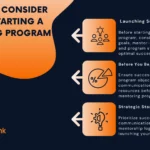
How to select the best mentoring software, easy one or right one? Which one is your favorite and which one is more important? 🙃
The best way of the select things is choosing them based on your needs. If you are reading this article, you can agree that you have taken the right step for your organization. There are a lot of players in the market now and with that comes difficulty in finding what software is right for your organisation and its needs.
In this article, we have clarified how you can select the right mentoring software platform for your organization.
User Experience
Importance of user-friendliness in mentoring software ♥
User-friendliness is crucial in mentoring software for several reasons:
- Adoption
- Efficiency
- Engagement
- Satisfaction
- Cost-effectiveness
Therefore, a user-friendly mentoring software interface is critical to the success of any mentoring program. By choosing software that is intuitive, easy to use, and provides a positive user experience, organizations can increase engagement levels, improve program outcomes, and achieve a higher return on investment for their mentoring program.
How to evaluate the user-friendliness of different software options 👩🏻🏫
To evaluate the user-friendliness of different mentoring software options, consider the following factors:
- Navigation: Evaluate how easy it is to navigate the software and find the features and tools that you need. The navigation should be intuitive, with a clear menu structure and simple icons or buttons that are easy to understand.
- Onboarding: Assess how easy it is for new users to onboard and start using the software. The software should have a clear and simple onboarding process that guides users through the initial setup and configuration.
- Interface design: Consider the overall design of the software interface, including the use of color, fonts, and graphics. The interface should be visually appealing and easy to read, with a clean and uncluttered layout.
- Functionality: Evaluate the functionality of the software and how easy it is to use the different features and tools. The software should be designed to streamline tasks and reduce the need for manual data entry or duplication of effort.
- User feedback: Gather feedback from current users of the software to understand their experience and identify any areas for improvement. Consider conducting user surveys or focus groups to gather feedback and identify any pain points or usability issues.
- Help and support: Evaluate the quality and availability of help and support resources, such as user manuals, online tutorials, and customer support. The software provider should offer comprehensive support to ensure that users can easily resolve any issues or questions.
Therefore, by considering these factors, organizations can evaluate the user-friendliness of different mentoring software options and select a solution that meets their specific needs and provides a positive user experience for mentors and mentees.
Customization Options
The benefits of customizable mentoring software ℹ
Customizable mentoring software offers several benefits for organizations, including:
- Tailored to specific needs
- Flexibility
- Better user experience
- Improved data tracking
- Greater control
- Cost-effective
Thus, by choosing a customizable software solution, organizations can tailor their mentoring program to their specific needs and achieve better outcomes for their mentors and mentees.
Different levels of customizability and how to decide the right level 👨🏾🏫
When choosing a customizable mentoring software solution, it’s important to consider the different levels of customizability available. There are generally three levels of customizability:
- Basic customization: This level of customization typically includes basic branding and customization options for workflows, forms, and reports.
- Advanced customization: Advanced customization provides greater flexibility and control over the software. Organizations can add or remove features and modules, configure workflows and business rules, and integrate the software with other systems. This level of customization often requires more technical expertise and may require the assistance of the software provider or an IT team.
- Full customization: Full customization offers the greatest level of flexibility and control over the software. Organizations can create a fully custom solution tailored to their unique needs, including custom features, workflows, and interfaces. This level of customization often requires significant resources and technical expertise.
When choosing the right level of customizability for your needs, consider the following factors:
- Budget
- Technical expertise
- Program complexity
- Scalability
To explain, by considering these factors, organizations can select a solution that meets their specific needs and provides the right level of customization for their mentoring program.
System Integration
Importance of integration with other tools✅
Integration with other tools is an important consideration when choosing a mentoring software solution. Here are some reasons why:
- Improved data management: Integration with other tools such as HRIS or LMS systems can help streamline data management and eliminate duplicate data entry. This saves time and reduces the risk of errors.
- Increased productivity: Integration with other tools can automate tasks and workflows, improving productivity and freeing up time for mentors and program administrators.
- Enhanced reporting and analytics: Integration with other tools can provide more comprehensive reporting and analytics capabilities, allowing program administrators to track key metrics and identify areas for improvement.
- Better communication and collaboration: Integration with other tools such as video conferencing or messaging platforms can facilitate communication and collaboration between mentors and mentees. Also can improving engagement and participation in the program.
- Greater flexibility: Integration with other tools can provide greater flexibility and customization options for the mentoring program.
- Cost-effectiveness: Integration with other tools can be a cost-effective way to add functionality to the mentoring program without the need for custom development.
Therefore, when choosing a mentoring software solution, organizations should consider the integration options available. Also choose a solution that can integrate with other tools as needed to support their program goals.
Different types of integrations and how to choose the right ones for your needs👨🏼🏫
There are several types of integrations that mentoring software can offer. Here are some of the most common types of integrations and how to select the right ones for your needs:
- HRIS Integration: HRIS integration can help automate administrative tasks, reduce data entry errors, and streamline reporting.
- LMS Integration: LMS integration can enable seamless tracking of employee development, enable the mentee to access relevant training material, and make it easy for employees to manage their learning activities.
- Video Conferencing Integration: This integration can enhance communication and collaboration between the mentor and mentee, increase program engagement, and improve the overall experience of the mentoring program.
- Email and Calendar Integration: This integration can help mentors schedule and send reminders to mentees, and keep track of scheduled meetings, and follow-ups.
- Analytics and Reporting Integration: This integration can enable data-driven decision-making, improve the performance of the mentoring program, and help organizations understand how the program is performing.
When choosing the right type of integration for your needs, consider the following:
- Program Goals: Consider the goals of your mentoring program and which integration types will help you achieve those goals.
- Budget: Consider the cost associated with integrating the software and whether it fits within your organization’s budget.
- Technical Expertise: Consider the technical expertise required for each type of integration and whether your team has the necessary expertise to integrate the software.
- Ease of Use: Consider how easy it is to use and maintain each type of integration.
To explain, by considering these factors, organizations can choose the right integration types that support their mentoring program goals. Also enable a more seamless experience for their mentors and mentees.
Analytics and Reporting
The importance of analytics and reporting in mentoring software📃
Here are some reasons why analytics and reporting are important:
- Measure program effectiveness: Metrics such as the number of mentor-mentee pairs, completion rates, and satisfaction scores can help evaluate the effectiveness of the program and identify areas for improvement.
- Identify patterns and trends: This insight can help identify patterns and trends that can be used to improve the mentoring program.
- Make data-driven decisions: By analyzing data, organizations can identify which mentoring practices are working and which are not, allowing them to adjust the program accordingly.
- Track program ROI: This information can be used to justify the cost of the program and make adjustments to increase its effectiveness.
- Demonstrate program value: By providing data and insights into program performance, organizations can show the impact of mentoring programs on the organization’s goals and objectives.
Hence, by leveraging analytics and reporting, organizations can improve their mentoring programs, justify the cost of the program. Also demonstrate the value of the program to stakeholders.
Types of analytics and reporting features to look for📚️
Here are some types of analytics and reporting features to look for:
- Engagement Metrics: These metrics help measure the level of engagement between mentors and mentees, including the number of mentoring sessions, frequency of meetings, and completion rates. This information can help organizations identify areas for improvement in the mentoring program and adjust the program accordingly.
- Satisfaction Metrics: These metrics measure the satisfaction levels of both mentors and mentees with the mentoring program. Surveys and feedback mechanisms can help gather this information. Also provide insights into how well the program is meeting the needs of its participants.
- Performance Metrics: These metrics measure the impact of the mentoring program on individual and organizational performance. This can include metrics such as employee retention rates, productivity, and skill development.
- Progress Tracking: This feature enables mentors and mentees to track their progress throughout the mentoring program. This can include tracking goals, milestones, and progress against learning objectives.
- Customizable Dashboards: Customizable dashboards provide an overview of key metrics and insights into the mentoring program. These dashboards can be customized to suit the specific needs of the organization and provide a clear view of program performance.
- Real-Time Analytics: Real-time analytics provide up-to-date information about the mentoring program and can help organizations make data-driven decisions quickly. This feature can help organizations identify areas for improvement in the program and make adjustments in real-time.
To clarify, by leveraging these features, organizations can gain insights into the effectiveness of their mentoring program and make data-driven decisions to improve the program.
Data Privacy, Security and Compliance
The importance of security and compliance in mentoring software🛡️
Security and compliance are essential features of mentoring software to ensure that sensitive information is protected and legal requirements are met. Here are some reasons why security and compliance are important:
- Protect sensitive information: Mentoring software often contains sensitive information, such as employee performance data, personal information, and confidential business information. Security measures such as encryption, access controls, and data backup are critical to protecting this information from unauthorized access, theft, or loss.
- Meet legal requirements: Organizations have legal obligations to protect sensitive information under data privacy laws such as GDPR and CCPA. Mentoring software must comply with these regulations to avoid legal penalties and reputational damage.
- Maintain trust and credibility: Security breaches can damage an organization’s reputation and erode trust with employees, customers, and stakeholders. By implementing strong security measures, organizations can demonstrate their commitment to protecting sensitive information and maintaining the trust of their stakeholders.
- Mitigate risks: Security breaches can result in financial loss, legal penalties, and loss of intellectual property. By implementing security measures, organizations can mitigate these risks and avoid potential damage to the organization.
- Ensure continuity of operations: In the event of a security breach or data loss, organizations must have backup and recovery procedures in place to ensure continuity of operations. Mentoring software must have robust backup and recovery mechanisms to ensure that critical data can be restored quickly.
To explain, organizations must carefully evaluate the security and compliance features of mentoring software to ensure that the software meets their requirements and provides adequate protection for sensitive information.
What to look for in terms of security and compliance features👩🏼🏫
When evaluating mentoring software, there are several key security and compliance features to look for. Here are some of the most important features to consider:
- Data Encryption: Mentoring software helps to prevent unauthorized access to data and ensure that data is secure.
- Access Controls: Access controls should be in place to ensure that only authorized users can access sensitive data. Mentoring software should include role-based access controls, multi-factor authentication, and password policies to ensure that only authorized users can access sensitive data.
- Compliance Certifications: Look for mentoring software that has undergone compliance audits and has certifications such as SOC 2, HIPAA, or GDPR. These certifications demonstrate that the software has been tested and meets industry-standard security and compliance requirements.
- Data Backup and Recovery: Mentoring software should include backup and recovery mechanisms to ensure that critical data can be restored in the event of data loss. The software should also include disaster recovery procedures to ensure continuity of operations in the event of a disaster.
- User Activity Monitoring: User activity monitoring can help detect and prevent unauthorized access to data. Mentoring software should include user activity logs that track user activity and alert administrators of any suspicious activity.
- Data Retention Policies: Mentoring software should have data retention policies that specify how long data is retained and how it is deleted. This helps to ensure that data is not retained longer than necessary and is deleted in a secure manner.
- Vendor Security: If the mentoring software is hosted by a third-party vendor, it is important to evaluate the vendor’s security practices. So the vendor should have strong security controls, compliance certifications, and a track record of providing secure and reliable services.
Therefore, these features help to ensure that sensitive data is protected and that the software meets industry-standard security and compliance requirements.
User Support and Mentor Mentee Training
The importance of support and training in using mentoring software💯
Support and training are essential when implementing and using mentoring software. Here are some reasons why support and training are important:
- Onboarding: When implementing a new mentoring software, users will need to be trained on how to use the software effectively. Onboarding and training programs can help users learn how to use the software, understand its features and capabilities, and become comfortable with the system.
- Technical Support: Mentoring software is complex and may require technical support from the vendor. Support services can help users troubleshoot technical issues, answer questions about software features, and provide guidance on how to use the software effectively.
- User Adoption: Without proper training and support, users may be hesitant to adopt the new mentoring software. A lack of user adoption can lead to low usage rates, decreased engagement, and reduced value from the software.
- Customization: Mentoring software can be customized to meet the unique needs of each organization. Support and training services can help organizations understand how to customize the software to their specific needs and ensure that the software is configured optimally.
- Updates and Upgrades: Mentoring software vendors frequently release updates and upgrades to improve the software’s functionality, security, and performance. Support and training services can help users understand how to use new features and navigate changes in the software.
- Continuous Improvement: Mentoring software is a tool for continuous improvement and development. Support and training services can help users learn how to leverage the software to drive ongoing development and growth.
Thus, they can help users onboard and become familiar with the software, provide technical support and guidance, promote user adoption. Because of this they can help navigate updates and upgrades, customize the software, and drive ongoing development and growth.
What to look for in terms of support and training options ℹ
When evaluating mentoring software, it is important to consider the available support and training options. Here are some factors to consider when evaluating support and training options:
- Availability: The vendor should offer timely and responsive support services, including email, phone, and chat support. Look for a vendor with a strong customer support team that is available during business hours in your time zone.
- Onboarding and Training: The vendor should provide onboarding and training programs that are tailored to your organization’s needs. Look for a vendor that offers comprehensive onboarding and training programs, including self-guided training modules, virtual training sessions, and on-site training.
- Documentation: The vendor should provide detailed documentation, including user guides, training manuals, and knowledge base articles. Look for a vendor that offers searchable documentation that is regularly updated and covers all aspects of the software.
- Community Forums: The vendor should offer a community forum or user group where users can ask questions, share best practices, and exchange ideas. Look for a vendor that has an active user community with a robust discussion forum and frequent updates.
- Support SLAs: The vendor should have service level agreements (SLAs) in place that guarantee response times and resolution times for support requests. Look for a vendor that offers reasonable SLAs and has a track record of meeting them.
- Personalized Support: Look for a vendor that offers personalized support and training services, including access to a dedicated account manager or customer success representative. This can help ensure that you receive the support and guidance you need to succeed with the software.
To explain, look for a vendor that offers timely and responsive support services, comprehensive onboarding and training programs, detailed documentation, an active user community, reasonable support SLAs, and personalized support and training services.
Conclusion
Summary of the key factors to consider when choosing mentoring software
Here is a summary of the key factors to consider when choosing mentoring software:
- User-Friendliness: Look for software that is easy to use and intuitive, with a simple and intuitive interface.
- Customizability: Consider the level of customization options available, and select software that can be tailored to your specific needs.
- Integration: Look for software that integrates with other tools you are already using, to streamline your workflow and ensure a seamless user experience.
- Analytics and Reporting: Select software that offers robust analytics and reporting features, to help you track progress and measure success.
- Security and Compliance: Look for software that prioritizes security and compliance, with features such as data encryption and access controls.
- Support and Training: Choose software that offers comprehensive support and training options, including onboarding, documentation, community forums, and personalized support.
By considering these key factors when evaluating mentoring software, you can choose a solution that meets your organization’s needs and helps you achieve your mentoring goals.
Call-to-action for readers to evaluate their needs and start researching different software options.
If you’re considering implementing mentoring software for your organization, it’s important to evaluate your needs and research different software options. Use the key factors outlined above as a guide to help you choose the right software for your organization. Don’t forget to involve key stakeholders in the decision-making process and to test out different software options before making a final decision.
Must be remembered, investing in the right mentoring software can help you streamline your mentoring program, measure success, and achieve your organization’s mentoring goals. So, start evaluating your needs today and start researching different software options to find the best fit for your organization.


